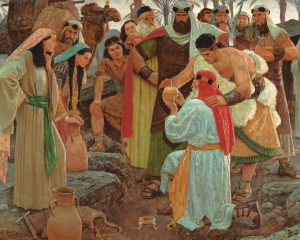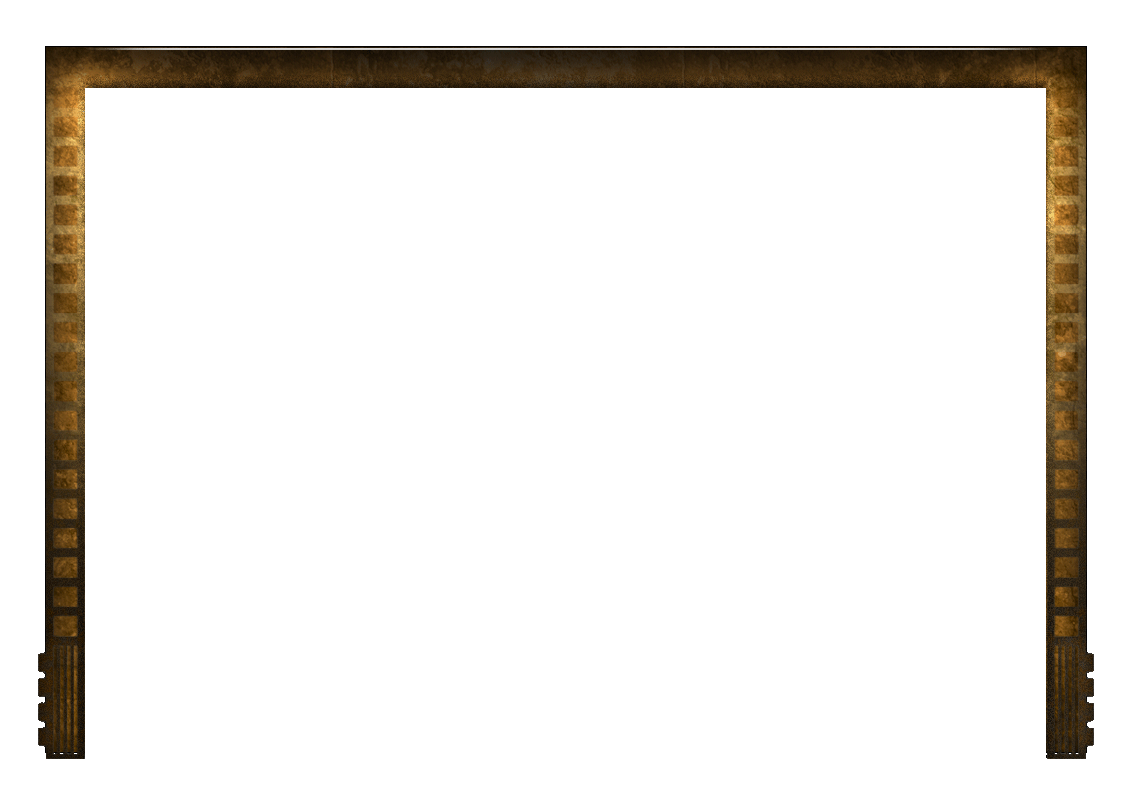Culture in the Old and New World
Journey of Faith tracks the journey started in 600 bc by the Israelite Prophet Lehi and his family as they made their exodus from Jerusalem across the Arabian desert to the coast, and there to the New World. Lehi’s son, Nephi, begins the account in 600 bc, preserving it by engraving on metal plates. The narrative did not come to light until the 1820s, when by divine revelation, Joseph Smith was directed to the plates and unearthed them from a hill in upstate New York. From them he translated the Book of Mormon: Another Testament of Jesus Christ.
 The Book of Mormon contains accounts by several different people over a thousand years, harmonized into a whole narrative by a father and son, Mormon and Moroni, who lived around 400 ad., including the visit of Jesus Christ to the Nephite people in the Americas after His resurrection. Although discovery of archaeological evidence of the Nephite civilization in the Old and New World is in its infancy, a reasonable amount of work has been done on the text itself that sheds light on its ancient origins.
The Book of Mormon contains accounts by several different people over a thousand years, harmonized into a whole narrative by a father and son, Mormon and Moroni, who lived around 400 ad., including the visit of Jesus Christ to the Nephite people in the Americas after His resurrection. Although discovery of archaeological evidence of the Nephite civilization in the Old and New World is in its infancy, a reasonable amount of work has been done on the text itself that sheds light on its ancient origins.
The second part of this article presents some snippets of information gleaned from the text that highlight the authenticity of its description of the environs in which its authors lived.[1] Such internal evidences can easily be divided into those from the Old World and those from the New World.
Internal Evidences from the Old World
Double, Sealed Documents
John W. Welch has highlighted several legal elements present in the Book of Mormon that hark back to ancient customs, customs of which Joseph Smith could have had no knowledge. For instance, the Book of Mormon itself was written on metal plates, but about two-thirds of the book were sealed.[2] Welch explains the concept of a sealed portion:
When written on parchment or papyrus, legal documents were written on a single sheet, but the text was written twice, once at the top and again at the bottom of the sheet. The repeated text could be either a verbatim copy or an abridgment of the full text. The document was then folded so that one part was open for inspection and use, while the other part was protected and sealed.
This practice is evidenced in Jeremiah 32. Jeremiah had bought a tract of land,
notwithstanding the prophecy that Jerusalem would also soon fall to the invading Babylonians (see v. 3). In order to memorialize his purchase as impressively and as permanently as possible, Jeremiah as purchaser drafted and executed not just a single document but a two-part deed. One part of its text “was sealed according to the law [mitzvah] and custom [Huqqim]” and the other part of the document “was open” (v. 11; compare v. 14). Jeremiah signed this double document and sealed it, as did several other people who witnessed the transaction and subscribed the text (see vv. 10, 12). Moreover, in order to preserve this evidence of his purchase, Jeremiah took his doubled, sealed document and, in the presence of his witnesses, securely deposited it with both of its parts in a clay jar, “that they may continue many days” (v. 14). [3]
The Book of Mormon prophet, Lehi, was a contemporary of Jeremiah, and it is thus reasonable to assume that the Nephites would have been conversant with this legal practice.
The Exodus Motif
Daniel C. Peterson has pointed out that when Book of Mormon authors narrated the flights of their people, they often compared them to the biblical Exodus, since that would have been very familiar to a people of Israelite origin.
Shortly after the group’s arrival in the Americas, Nephi, feeling menaced by the people of Laman and Lemuel, led his faithful followers—including Jacob—away from the land of their “first inheritance.” Still later, groups led by Mosiah, Alma, and Limhi, as well as the entire people of Anti-Nephi-Lehi, similarly abandoned their homes for new lands, impelled by deep religious visions and led by prophets. In fact, the Nephites appear to have seen their repeated exodus experiences as archetypal expressions of their individual and collective spiritual journeys. They were, as Alma said more than five centuries after their arrival in the Americas, “wanderers in a strange land.”[4]
Internal Evidences from the New World
John L. Sorenson has devoted much of his life to the study of the Nephite civilization in the New World.[5] A brief rehearsal of one of his discoveries will hopefully lead us to a deeper study of Sorenson’s great work. More of his external evidences found in the New World will be covered in a further article.
Weights and Measures
Sorenson narrates that “Alma’s experience with the antagonist Zeezrom in the city of Ammonihah as reported in Alma 11 describes a system of standard weights and volumes in use among the Nephites in their commerce.”[6] Research has shown that,
When the Spanish invaders arrived, they reported that in the markets everything was sold by volume. For example, the Aztecs used a wooden box, called quauhchiaquihuitl, to measure corn and other dry goods; this box was divided until the smallest unit was a twelfth part of the whole. Graded sizes of jars served to measure liquid. They also had special cups to measure out gold tribute payments to the Spanish in units roughly equivalent to our ounces.[7]
John W. Welch adds a clarification that grounds this system firmly in antiquity:
Promoting economic stability was a general goal behind Mosiah’s royal system of weights and measures. The text clearly states that this system was “established by king Mosiah” (Alma 11:4). . . . King Mosiah’s statute contains similarities to other ancient law codes antecedent to the Nephite system. For example, similarities appear almost effortlessly in the law code of Eshnunna, which was compiled about 1800 BC in a Babylonian city by that name that lay approximately 50 miles northeast of Baghdad in modern Iraq.[8]
Ancient American Civilization
In his introduction to his survey of the details of Ancient American civilization contained in the Book of Mormon, Sorenson asserts,
Some statements in the Book of Mormon about ancient Near Eastern lands, concepts, and activities might have been incorporated into the Nephite text because a nineteenth-century writer, such as Joseph Smith Jr. or Sidney Rigdon, knew about ancient lifeways through reading the Bible or secular sources accessible before 1830. But once the Book of Mormon story claims to be taking place in an American setting, such an argument makes no sense, for nobody knew enough by 1830 to get so many facts right. At point after point the scripture accurately reflects the culture and history of ancient Mesoamerica (southern Mexico and northern Central America).[9]
Sorenson then goes on to list parallels between the Nephites and what is now known (but could not have been known in 1830 when Joseph translated the Book of Mormon) about Mesoamerica in the area of level of civilization, geographical consistency, the pattern of culture, history, and language. He concludes,
Dozens of similarly provocative correlations could be documented. In the ones just sketched, as in the many left unmentioned, we are left to marvel at how Joseph Smith managed to dictate—in a few months and without significant editing—such a book that time and again matches up with life and events in ancient Mesoamerica. Not a single scholar in young Joseph’s day knew enough to get any, let alone all, of these things right. One must ask, how then did he do it? The only choices available to answer the question seem to be (1) that he was an unbelievably creative writer, for which we have no other evidence, or (2) that he had access to an actual ancient Mesoamerican book.[10]
It is hoped that this brief survey of the internal cultural evidences of the Book of Mormon will provoke the reader to a greater study of the sources provided and others readily available on the Neal A. Maxwell Institute website, and eventually lead the seeker of truth to a knowledge of the divine origins of the Book of Mormon: Another Testament of Jesus Christ.
[1] The Neal A. Maxwell Institute for Religious Scholarship has published several books that throw light on the ancient origins of the Book of Mormon from the text alone. For instance, Daniel C. Peterson, Donald W. Parry, and John W. Welch, eds., Echoes and Evidences of the Book of Mormon (Provo, UT: FARMS, 2002); Noel B. Reynolds, ed., Book of Mormon Authorship: The Evidence for Ancient Origins; and Reynolds, ed., Book of Mormon Authorship Revisited: New Light on Ancient Origins (Provo, UT: FARMS, 1997). The Institute’s flagship publication, now titled Journal of Book of Mormon and Other Restoration Scripture, has published many articles dealing with internal and external evidences over the years.
[2] Orson Pratt, Journal of Discourses, Vol. 3, p. 347; Joseph Smith—History 1:65; see Ether 4:5.
[3] John W. Welch, “A Steady Stream of Significant Recognitions,” in Echoes and Evidences. For a fuller treatment, see “Doubled, Sealed, Witnessed Documents: From the Ancient World to the Book of Mormon,” in Mormons, Scripture, and the Ancient World, ed. Davis Bitton.
[4] Daniel C. Peterson, “Not Joseph’s, and Not Modern,” in Echoes and Evidences.
[5] See a bibliography of his works; A Bibliography of the Published and Unpublished Works of John Leon Sorenson.
[6] John L. Sorenson, “Did the Ancient Peoples of Mesoamerica Use a System of Weights and Scales in Measuring Goods and Their Values?” JBMS 8/2 (1999); see also John W. Welch, “Weighing and Measuring in the Book of Mormon,” JBMS 8/2 (1999).
[7] Sorenson, “Did the Ancient Peoples.”
[8] Welch, “Weighing and Measuring.”
[9] John L. Sorenson, “How Could Joseph Smith Write So Accurately about Ancient American Civilization?” in Echoes and Evidences.
[10] Sorenson, “How Could Joseph Smith?”

